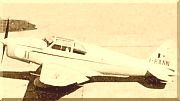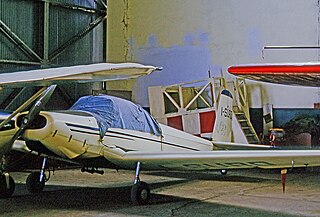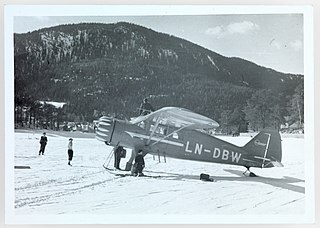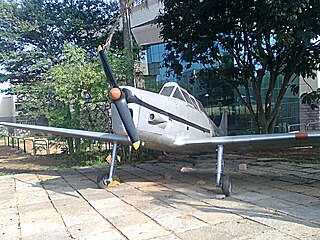The Aerauto PL.5C was a roadable aircraft developed in Italy in the early 1950s. It was a high-wing two-seat monoplane whose wings could be folded to quickly transform it into an automobile. It was different from many such projects in that it used its pusher propeller for propulsion not only in the air, but on the road as well. Development was abandoned in 1953.

The Aero-Flight Streak was an American two-seat light aircraft built in 1946 by Aero-Flight Aircraft Corporation at Buffalo, New York. Advanced for its time, it was of all-metal construction with tricycle undercarriage, and accommodated the pilot and passenger in tandem beneath a sliding, bubble canopy.

The Agusta A.115 was a prototype helicopter flown in 1961 in Italy. It was essentially a Bell 47J-3 with an unclad, tubular tail boom, and powered by a Turbomeca Astazou II turboshaft engine. No production ensued.

The Agusta AZ.8L, or Agusta-Zappata AZ.8L, was an Italian airliner prototype first flown on 9 June 1958. It was of conventional low-wing monoplane configuration with tricycle undercarriage and all-metal construction. Filippo Zappata's design grew out of a twin-engined transport designated AZ.1 that was never built.

The Alaparma Baldo was an unusual two-seat light monoplane produced in Italy shortly after World War II. Designed by Adriano Mantelli, it featured an egg-shaped fuselage with cabin doors that hinged upwards and to the back. The conventional tailplane with single fin and rudder was carried on twin booms, either side of a pusher engine installation. The undercarriage consisted of a single mainwheel under the fuselage pod, a small tailwheel not far behind it, and outrigger wheels on the wingtips.

The Ambrosini S.1001 Grifo ("Griffin") was an Italian light airplane that appeared shortly after the end of World War II. The first plane built by SAI Ambrosini postwar, the prototype flew in 1947 and was derived from the pre-war SAI.2S. It was a four-seat monoplane with spatted fixed undercarriage. A small series was produced for the Italian aeroclubs with an Alfa Romeo 110-ter engine of 97 kW (130 hp). Three examples were even bought by the Italian Aeronautica Militare (AMI), which used them between 1948 and 1950.

The Aviamilano P.19 Scricciolo was a light civil trainer aircraft built in Italy in the 1960s.

The Avions Fairey Belfair, also known as the Tipsy Belfair after its designer, Ernest Oscar Tips, was a two-seat light aircraft built in Belgium following World War II.
The Breda-Pittoni B.P.471 was an Italian twin-engine airliner/military transport produced by Breda.

The Widerøe C.5 Polar, sometimes known as the Honningstad C.5 Polar, was a Norwegian general-purpose land or floatplane built by Widerøes Flyveselskap.
The Brochet MB.120 was a two-seat light aircraft developed in France in the 1950s.

The Colonial Model C-1 Skimmer was an American small single-engined amphibian flying boat built by the Colonial Aircraft Corporation. It was the start of a line of very similar aircraft designed by David Thurston.

The Caproni Vizzola C22 Ventura was a light jet-powered aircraft developed in Italy for use as a military trainer. It was of conventional sailplane configuration and bore a family resemblance to the Caproni Calif gliders, although the Ventura had an almost entirely metal structure. The student and instructor sat side by side under an expansive canopy, and weapons hardpoints were provided under each of the slender, high-mounted wings. It had retractable, tricycle undercarriage.

The HAL HT-2 is an Indian two-seat primary trainer designed and built by Hindustan Aeronautics Limited (HAL). The HT-2 was the first company design to enter production in 1953 for the Indian Air Force and Navy, where it replaced the de Havilland Tiger Moth. The HT-2 is a low-wing cantilever monoplane with a fixed tailwheel landing gear. Powered by a 155 hp (116 kW) Cirrus Major III piston engine, the aircraft has enclosed tandem cockpits with dual controls. Apart from military use, the aircraft was also used by Indian flying schools.

The SIAI-Marchetti SM.102 was a 1940s Italian light transport cabin monoplane designed and built by SIAI-Marchetti.

The SAI KZ IV was a light twin-engined aircraft first built in Denmark in 1944 for use as an air ambulance.

The MDG Midgy-Club was a post-war cabin biplane designed and built by Instruments de Precision M.D.G at Garches, France. The company designed and built precision instruments and due to the close relationship with the aviation industry, the company designed and built two aircraft. The first, MDG LD.45, was a single-seat biplane. The MDG LD-261 Midgy-Club was a follow-on design with an enclosed cabin with two seats arranged in tandem layout. It was built in small numbers.

The Agusta A.105 was an Italian rotorcraft designed by Agusta. It was never developed beyond the prototype stage.

The Ambrosini Rondone is an Italian-designed two/three-seat light touring monoplane of the early 1950s.
The Maestranza Central de Aviación Triciclo-Experimental was a prototype Chilean light aircraft of the 1940s.
















